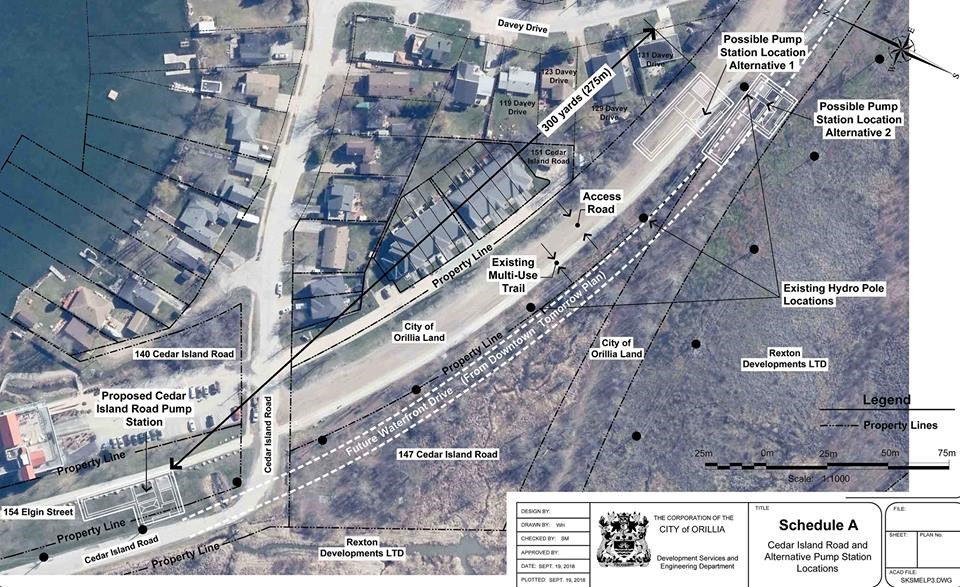City council has, finally, approved the construction of a new sewage pumping station on Cedar Island Road near the Elgin Bay condominium on the shore of Lake Couchiching.
The controversial site, on land owned by the city but adjacent to the parking lot of the condo at the edge of the Lightfoot Trail, was selected several months ago after a lengthy process that included two public meetings.
However, when residents in the area learned about the location after it appeared on a city council agenda in early June, the sewage hit the fan.
Residents in the condo and in the nearby neighbourhood organized and rallied and challenged council to find a more suitable location.
At the time, Tom Griffiths, a retired environmental consultant who lives in the condo, said residents believed the pumping station would be an eyesore, they were concerned about noise from a diesel generator and, most importantly, claimed the location was a potential for disaster.
“What if they had a major spill?” asked Griffiths. “It’s going to go in the lake.”
He said it makes no sense to build such a facility on a floodplain beside a creek that flows into the lake. He also expressed concern about storing sewage on the site, below the water table, and worried about potential spillage from the generator.
In the face of those concerns and growing controversy, council explored other options and postponed a decision three different times over four months.
However, in the end, the costs associated with moving the station to a new location proved too onerous. During the process, they learned a move would not only cost up to $500,000 (to move to a location 300 yards south) but also potentially delay the waterfront redevelopment plan significantly.
“I believe we’ve exhausted every possible site,” Coun. Pat Hehn said Monday night.
She then won her colleagues’ support for a pair of amendments aimed at making the location more palatable for upset neighbours.
One amendment calls for the city to add up to $50,000 to the approximately $4-million project budget to design the look of the building to ensure it reflects the neighbourhood.
The second amendment will add an additional $100,000 to the project to increase the size of the building so that the exterior generator can be moved inside the building in an effort to mitigate noise.
Prior to approving that concept, Ian Sugden, the city’s director of development services, warned councillors that staff recommended the generator be outside the building because it’s easier to access and easier to service.
It was also noted the generator would only be used in an emergency. Otherwise, it would be tested for about one hour each week or each month depending on the model chosen.
After the lengthy meeting, Griffiths said city council is missing the point. He has vowed to appeal the decision not based on the look of the building or the potential noise generated.
An appeal “doesn’t have anything to do with aesthetics,” he said. “It’s strictly (based on the) potential environmental harm.”
Griffiths said an appeal is likely, but he will wait until the environmental study is published to decide.
As he did two weeks ago, Coun. Mason Ainsworth appealed to his council colleagues to allow the next council to make the decision on the controversial site.
“I think it would only be respectful if this council passed it on to the next council and let them decide,” said Ainsworth, noting “we are right smack dab in the middle of an election with 21 days to go.
“The reality is we don’t know who’s going to be sitting around this table and I think that’s a decision they need to make,” said the Ward 3 councillor.
But the majority of council did not agree.
“We have been working for almost two years now on the waterfront development process,” said Coun. Ted Emond. “We are very close to putting together (a request for proposals) to go out and seek development proposals for the properties around Metro and the waterfront lands. Unfortunately, this pumping station is bundled in with that. I am opposed to any postponement that would delay that process and bringing those development opportunities forward for the benefit of the majority of Orillians.”
Coun. Tim Lauer, who had been pushing for an alternate site 300 yards south of the chosen location, agreed.
After learning about the costs associated with that location and after hearing residents along Davey Drive might also rally against that new location, he said it was time to make a decision.
“This is a tough one, there’s no doubt about it,” said the Ward 4 councillor. “I think it’s important this council make a decision on this. I really feel uncomfortable passing it off to the next council.”
In the end, council approved the location. With that green light, the next phase of the project kicks in. That is the preparation of an environmental study report. It is expected that will be ready to be published in mid-January.
The day it’s published, a 30-day appeal period begins. If there is no appeal, the project would move to the design phase. If there is an appeal, the province has 66 days to respond.
